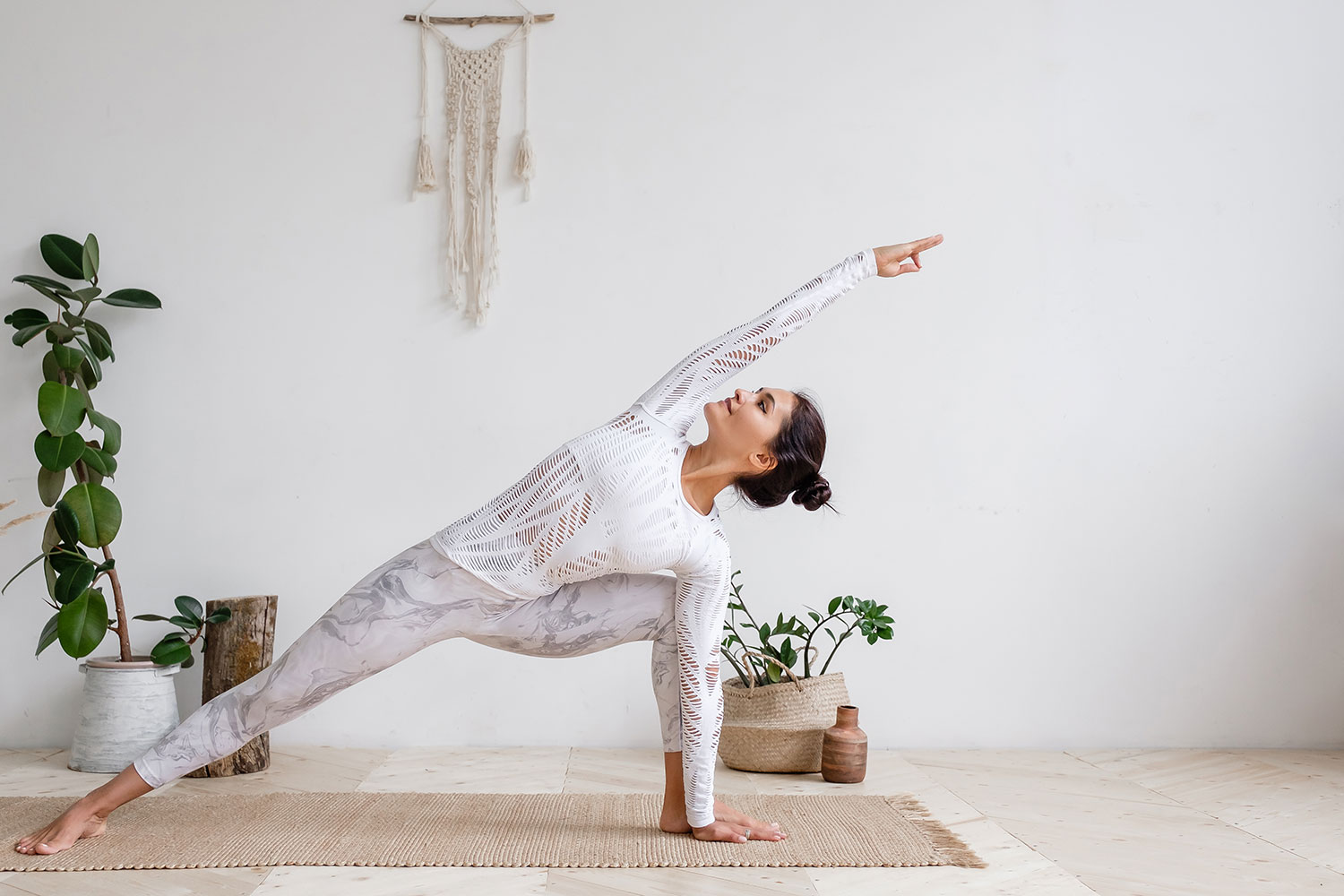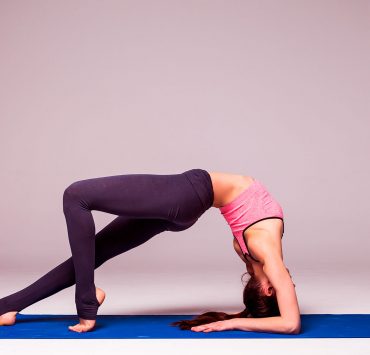
After spending nearly two decades as a relationship therapist, Patricia…
Starting a yoga journey can appear a bit daunting in a world filled with fancy inversions and bizarre contortions. Fortunately, in many classes, you’ll come to meet the same foundational poses, and before you know it, they’ve become second nature. It’s essential to start with the basics and grow comfortable with the movement of your body before rushing forward. The poses outlined below will give you the framework for a more advanced practice if you choose to continue challenging yourself. However, it’s not uncommon to stay within the realm of these initial shapes as they hold a plethora of mental and physical health benefits. Move at your own pace and always listen to what your body is saying to avoid injury or discomfort.
Salamba Balanasana — Child’s Pose

Child’s pose is the perfect place to go when you need to collect your breath or soften through the back body. It’s a supportive and grounding shape that enhances the connection between mind and body while providing relief to the back and hips. Start in a tabletop position and bring the knees together for extra support, or wide with feet together for a deeper stretch. Walk the hands out and let the forehead come to rest on either the mat or a block. You could implement a bolster under the torso for a more therapeutic experience. As you breathe in feel the ribs draw apart to create space, and on the breath out feel the heart and hips settle down.
Setu Bandha Sarvangasana — Bridge Pose

Many workouts implement bridge pose to achieve tight glutes and legs. In yoga, bridge pose is an excellent backbend and heart opener for beginners as it can be modified to fit all skill levels. Come to lay on your back with knees bent and feet planted at hips distance. Plant your palms down and lift the hips towards the ceiling on an inhale by pressing down through the heels. Bring some space between the chin and the chest to lengthen the neck. Let the shoulders tuck under and maybe interlace the hands, rooting the arm bones down. If you’re craving something a bit more restorative, try bringing a block under the sacrum and resting there.
Paschimottanasana — Seated Forward Fold Pose

Many postures in yoga are great tools for witnessing a change in the body over time. Forward folds are an excellent example of this as you can quickly notice when you’ve gone deeper into a fold than before. Find a seated position with legs elongated in front, and any extra flesh moved from the sit bones. Find a straight spine as you inhale both arms overhead and draw the navel up and in. As you exhale, pull the kneecaps up the thighs to energize the legs and drape the upper body forward. Continue to breathe here, finding more length on each inhalation and softening down on each exhalation.
Virabhadrasana I — Warrior I Pose

The sequence of warrior postures certainly live up to their names, evoking power and stability in their form. To enter warrior I, start in downward facing dog and bring your left foot up between the hands. Turn your right foot flat at a 45-degree angle and inhale to rise by squeezing the thighs together and bringing the arm bones by the ears. Let the pinky fingers turn inward as the shoulder blades and tailbone descend. Continue to root through the knife edge of your right foot as you bend deeply into the left knee and pull the left hip back. Push towards the sensation and relish in the power of your legs to support this shape.
Virabhadrasana II— Warrior II Pose

Warrior II has the same powerful, challenging attributes as warrior I, but with the bonus of being a hip opener. From a standing position, step your left foot back to take a wide stance. Point your right toes forward and turn the left foot flat, making it that the front heel aligns with the back arch. Bring the arms out wide in a T-shape and the gaze over the front fingertips. Exhale and bend deeply into the front leg, stacking the knee over the ankle and pressing the thigh out. As you breathe in this shape, continue to isometrically pull the inner thighs together while reaching equally with both arms.
Virabhadrasana III — Warrior III Pose

Now take the power of the first two warrior postures and add in elements of increased balance and core stability. Warrior III requires a heightened level of concentration and trust to navigate. Start standing at the front of your mat and begin to shift weight into the left foot. On an exhale hinge forward at the waist while extending the right leg out behind. Hold a straight spine and keep the chest lifted to support the muscle activation of the legs. As you continue to breathe here, locate a stable point of focus and draw the thighs inward to find greater balance. Try to lessen the emphasis on becoming parallel to the mat and increase awareness of proper alignment.
Vrksasana — Tree Pose

Continuing on the journey to find balance and core activation brings us to tree pose. Begin standing at the head of your mat and begin to shift weight into your right foot. Slowly maneuver your left foot up to either your right inner thigh, mid-calf, or ankle. Drop the left knee behind to open the hip while the tailbone descends. Bring the hands to rest at heart center or raise them overhead for an extra challenge.
Trikonasana — Triangle Pose

You don’t have to create a perfect shape to experience the benefits of triangle pose. This posture strengthens the core and legs while lengthening the entire body. It may feel a bit unusual for the body to begin, but over time it will feel more natural. Come to stand at the head of your mat and step your right foot back into a wide-legged stance. Turn your left toes forward, so your front heel aligns with the arch of your right foot. Inhale your arms out to the sides, gazing beyond your left fingertips, and exhale to hinge forward at the waist while reaching with the front hand. Once you can’t reach any further, drop the front hand down to either your shin or perhaps a block, and lift the back arm straight up. Press down firmly through the back foot to tuck the tail and stack the hips. Continue to breathe into this shape for several cycles, feeling the core strength supporting you.
Phalakasana — Plank Pose

Most people are familiar with plank pose as being a challenging workout, but the proper alignment remains a mystery to many. Find your way to a tabletop position with wrist stacked under shoulders and fingers spread wide. On an inhale, pick the knees up and lengthen both legs straight back. Ground down firmly through the hands to broaden the upper back and avoid dropping weight into the chest and shoulders. Engage the legs and core to maintain a straight spine and fire up the posture. If this is too much in your practice to start, try holding with the knees down to isolate the upper body.
Adho Mukha Svanasana — Downward Facing Dog Pose

Many yoga classes feature downward dog several times as a resting pose between sequences, but if you’re new to this shape, it may not feel very restful at first. Your body will learn to love this posture through consistent practice and improvement. Come to all fours and bring your hands just ahead of the shoulders. Spread the fingers wide and root down in the space between the thumb and index. Tuck the toes and inhale to lift the knees up while engaging the core muscles. On your exhale, send the hips up and back to elongate the legs and arms. Allow your head and neck to go heavy between the arms and your thighs to press behind. Remember to keep energy in this posture by drawing everything towards the midline from your base. Breathe here for 3-5 rounds of breath, feeling the entire back line of the body.
Tadasana — Mountain Pose

Mountain Pose (Tadasana)For many, mountain pose appears pretty easy and straight-forward, but there’s a lot more than meets the eye. This stance is stable, strong, and activate in nature and requires keen attention to detail. Standing at the head of your mat with feet at hips distance, let the arms extend down by the sides. Draw the shoulders back and reach tall through the crown, feeling a lift from the lower abdomen to the head. Ground down with the entire lower body, starting with the tailbone and going out through both feet. Support the flow of energy in this posture by activating the legs, drawing the kneecaps up towards the thigh bones.
Marjaryasana — Cat/Cow Pose

Spinal waves are an excellent way to unite movement and breath while assessing the range of motion through the spine. Come to all fours with wrists stacked under shoulders and knees under hips. As you breathe in, allow the belly to drop towards the floor while the gaze and tailbone lift up. On an exhale, hollow through the abdomen to round the spine while tucking the chin and tailbone. Continue to wave through this motion for 3-5 cycles, following the breath to the very top and very bottom.
Utkatasana — Chair Pose

Some postures challenge both our mental and physical beings, bringing us to the edge of our comfort zone. Chair pose is that way for many people and requires a particular strength in body and mind. Standing at the head of the mat, bring your big toes to touch and leave roughly an inch between the heels. Inhale the arm bones up by the ears while simultaneously sinking low in the hips. Shift the weight into your heels and draw in through the lower belly. Continue to stay here, feeling the strength in the lower body and resisting the urge to leave the posture before taking 3-5 full breaths.
Bhujangasana — Cobra Pose

Backbending can be very tricky to navigate, for seasoned practitioners and beginners alike. The key is to stay mindful of what your body needs in every moment and not push beyond what’s beneficial. Cobra pose is a wonderful introduction to back-bending, leaving space for personal interpretation. Start by laying on your belly with palms planted under the shoulders. Inhale and press through the tops of the feet while grounding down into the pelvis as you rise. Use the muscles of the back to support this shape while maintaining an openness across the collarbones. Release down on an exhale and notice how the posture resonated with the spine.
Supta Baddha Konasana — Reclining Bound Angle Pose

Bound angle pose warms up the hip flexors and leaves space for moving forward with the upper body. From a seated position, bring the soles of the feet together and the knees wide. This posture can be explored with a block under the sit bones for extra support, or directly on the ground. Wrap the hands around the ankles and inhale deeply to reach up through the spine. On an exhale, drape the upper body towards the legs while letting the head and neck surrender. Other options include maintaining an upright position or perhaps bringing the heels further away from the sit bones to access different ranges within the hips.
Urdhva Mukha Svanasana — Upward Facing Dog Pose

Many yoga classes exhibit upward facing dog as the back-bending portion of a vinyasa sequence. It’s important to evaluate whether this posture will serve the spine well before attempting. Taking an exhale from plank pose, lower down halfway keeping the elbows tight to the body. Inhale to straighten the arms and flip over to the tops of the feet. Reach tall through the crown, draw the shoulders back, and press firmly through both feet to lift the kneecaps. Slowly release down on your exhale and feel the effects this movement has had on the body.
Purvottanasana — Reverse Plank Pose

You’ll certainly feel the burn in your core and shoulder muscles when navigating this pose. Sit with legs outstretched in front and palms planted just behind the hips. Take a deep breath in to lift the hips and gaze skyward. Energize the legs by pointing the toes, pressing the feet down, and squeezing the glutes. Maintain this shape for 3-5 rounds of breath. If this doesn’t feel good in the body just yet, try reverse tabletop instead.
Paripurna Navasana — Boat Pose

It’s not always smooth sailing in boat pose, and that’s totally normal as our bodies change from one day to the next. You’re sure to notice some heat building in the core as you challenge yourself to support this shape. Sit with knees bent, feet planted, and arms extended parallel to the mat. Shift back and find a balancing point around the sit bones as both feet leave the floor. Start by bringing the shins level with the floor, and determine from there whether you should push further or not. If you’re seeking more difficulty straighten the legs out, coming into a V-shape. Wherever you find yourself, continue to feel strong through the core and lifted in the heart space.
Utthita Parsvakonasana — Extended Side Angle Pose

Extended side angle is an excellent way to bring space to the waist and ribs. Take the same stance we explored for warrior II, feet wide with front heel aligned to back arch and a deep bend in the leading knee. Rest the front forearm down on your thigh as the back arm extends towards the front of the room. Feel the line of energy being created from the top fingertips and out through the back foot. Let each inhalation celebrate newfound space and relaxation within the side body.
Ardha Matsyendrasana — Seated Twist Pose

Twists are detoxifying for the entire body, nourishing the inner organs by circulating blood and gently massaging them. It’s important to recognize where the twists are originating from and where they end to ensure we aren’t forcing the motion. We have the highest range of motion in the cervical spine, so it’s common for twists to be started from this point and pushed through the lower body. Consider focusing the twist in the lower abdomen and spine then spiraling up from there. Find a seated position with your left leg extended straight and the right knee bent with the foot planted near the sit bones. Walk the right fingertips out behind and inhale the left arm straight up. Exhale to twist towards the right, hooking elbow on knee and perhaps letting the gaze travel over the right shoulder. Inhale length through the spine and exhale into a deeper twist.
Savasana — Corpse Pose

Many people assume corpse pose is the easiest posture of them all because you’re essentially just laying down, but this couldn’t be further from the truth. It takes a lot of mental control to lay motionless without jumping up to greet the next task. This is where we go to absorb the benefits of practice and let the mind rest without disruption. Try to keep attention on the steady flow of breath, noticing when the mind has wandered and gently pulling it back to the present moment.
What's Your Reaction?
After spending nearly two decades as a relationship therapist, Patricia journeyed down the path of writing as a vehicle for sharing her wisdom. Her work reflects a sincere interest in readers’ wellbeing and is abundant with helpful advice and fascinating insight.















We stumbled over here by a different website and thought I should
check things out. I like what I see so now i’m following you.
Look forward to looking at your web page again.